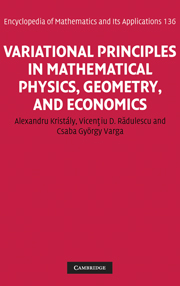 Variational Principles in Mathematical Physics, Geometry, and Economics
Variational Principles in Mathematical Physics, Geometry, and Economics Book contents
- Frontmatter
- Contents
- Foreword
- Preface
- Part I Variational principles in mathematical physics
- Part II Variational principles in geometry
- Part III Variational principles in economics
- Appendix A Elements of convex analysis
- Appendix B Function spaces
- Appendix C Category and genus
- Appendix D Clarke and Degiovanni gradients
- Appendix E Elements of set-valued analysis
- References
- Notation index
- Subject index
Appendix C - Category and genus
Published online by Cambridge University Press: 05 June 2013
- Frontmatter
- Contents
- Foreword
- Preface
- Part I Variational principles in mathematical physics
- Part II Variational principles in geometry
- Part III Variational principles in economics
- Appendix A Elements of convex analysis
- Appendix B Function spaces
- Appendix C Category and genus
- Appendix D Clarke and Degiovanni gradients
- Appendix E Elements of set-valued analysis
- References
- Notation index
- Subject index
Summary
Every human activity, good or bad, except mathematics, must come to an end.
Paul Erdös (1913–1996)Topological tools play a central role in the study of variational problems. Though this approach was foreshadowed in the works of Poincaré and Birkhoff, the force of these ideas was realized in the first decades of the twentieth century, in the pioneering works of Ljusternik and Schnirelmann [145] and Morse [163, 164]. In this section we recall the notions of Ljusternik–Schnirelmann category and Krasnoselski genus as well as some of their basic properties.
Definition C.1. Let M be a topological space and let A ⊂ M be a subset. The continuous map η: A × [0, 1] → M is called a deformation of A in M if η(u, 0) = u for every u ∈ A. The set A is said be contractible in M if there exists a deformation η: A × [0, 1] → M with η(A, 1) = {p} for some p ∈ M.
Definition C.2. Let M be a topological space. A set A ⊂ M is said to be of Ljusternik–Schnirelmann category k in M (denoted catM(A) = k) if it can be covered by k but not by k − 1 closed sets which are contractible to a point in M. If such a k does not exist, then catM(A) = ∞.
- Type
- Chapter
- Information
- Variational Principles in Mathematical Physics, Geometry, and EconomicsQualitative Analysis of Nonlinear Equations and Unilateral Problems, pp. 337 - 338Publisher: Cambridge University PressPrint publication year: 2010


